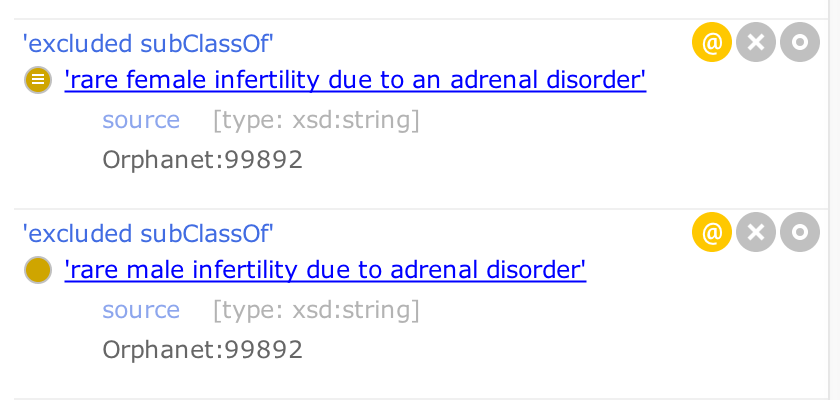Logical Axioms¶
Always have the reasoner on in Protege!!! Use the inferred view!
Use Elk, we generally stay within the EL++ subset. Sometimes UnionOf is used but this is not relied upon in inference.
Note if you don’t stay in the inferred view you will see a lot of redundant subclass assertions.
SubClassOf axioms¶
For normal ontology development we would avoid asserting axioms that can be inferred. Here we violate this dictum and assert a subClassOf axiom if it is true and it is asserted elsewhere (we annotate axiom with the source ID).
If we want to remove a subClassOf axiom that has external evidence, we turn it into a excluded_subClassOf annotation (non-logical) axiom.
Excluded subclassOf¶
Rather than removing a subClassOf that comes from a trusted source (like ordo), we usually turn it into an excluded_subClassOf annotation. For an example, see MONDO_0020528 'ACTH-dependent Cushing syndrome'

How to add an Excluded subclassOf annotation in Protege¶
- Click on the subclass you wish to exclude
- Command + U,
show full IRI, copy the URI - Navigate back to the class you wish to add the
excluded subClassOfannotation to - Add annotation to the class (click + in Annotations box)
- Click
excluded subClassOf - Click IRI Editor
- Paste IRI, click OK
- Click the @ symbol on the annotation to add an annotation
- Add
source, and add CURIE in literal tab - Delete
SubClass Ofannotation (in Description box)
Definitional Equivalence Axioms¶
In addition to SubClassOf axioms, we have EquivalenceAxioms conforming to design patterns. See the patterns folder for details.
https://github.com/monarch-initiative/mondo/tree/master/src/patterns
Currently equivalence axioms live in the main ontology file (but are exported to csvs in the patterns folder using dosdp-tools).
DPs are roughly:
- Based on location or affected structure (Uberon/CL/GO-CC)
- For infectious diseases, NCBITaxon for causal agent
- GO
- Rare X
For more information, see the Design Patterns page.
Currently we punt somewhat on semantics. We use ‘disease_has_location’ which has deferred some semantics, essentially to mean “should be classified under X disease”. We will have more discussion on this. We never over-describe with this relation, it is intended for primary location.
For example, see MONDO_0021726 'abdominal cystic lymphangioma'
Equivalent to:
'cystic lymphangioma'
and ('disease has location' some abdomen)